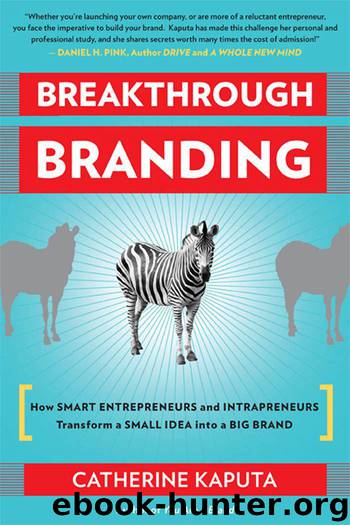Breakthrough Branding: How smart entrepreneurs and intrapreneurs transform a small idea into a big brand by Catherine Kaputa

Author:Catherine Kaputa [Kaputa, Catherine]
Language: eng
Format: mobi
Publisher: Nicholas Brealey Publishing
Published: 2012-04-01T14:00:00+00:00
TRADITIONAL TOUCHPOINTS (Your product design and packaging, your store, salespeople, marketing materials, advertising, etc. Try to list them in terms of importance.)
1.
2.
3.
4.
5.
6.
DIGITAL TOUCHPOINTS (Your website, e-newsletter, social media like Facebook, LinkedIn, and Twitter, review forums like Yelp, etc.):
1.
2.
3.
4.
5.
6.
Not All Touchpoints Are Created Equal
For decades, branders looked at consumer touchpoints using the funnel metaphor. A funnel, with its wide top and narrow bottom, was a good model for how the buying process for most products used to work. Typically, consumers began with a large array of possibilities (the top end of the funnel) and gradually pared down their choices to a small group, and finally to their purchase choice (the narrow end of the funnel).
Marketers directed most of their money to the two critical touchpoints, the top and bottom ends of the funnel. Big dollars went toward mass-market advertising, including TV commercials and print ads, in an attempt to build brand awareness on the largest scale possible.
Marketing money was also earmarked for promotions and product placement at the other end of the funnel—in stores—because in-store touchpoints are particularly powerful and can change everything. Studies show that up to 40 percent of consumers change their minds because of something they see or learn at the point of sale. The visual experience alone—the way a product looks or the presence of a prominent and intriguing display—can sway the consumer’s decision. Shoppers can also be influenced by what a salesperson says or by a great deal offered by one of the brands they are considering.
During the “funnel decades,” marketers were in control. Branding was a one-way communication from company to consumer. We call that push marketing, because the marketing message was pushed toward consumers. In the “push” era, it wasn’t easy for consumers to get comparative information or to voice their opinions directly to a manufacturer. Consumers were forced to rely on the marketing messages pushed at them in advertising, what they experienced at the point of sale, and what they heard from friends and associates.
Most people had little contact with a brand after purchase, other than the experience of using the product (or an interaction with customer service if something went wrong).
All was status quo in the branding and media world until the rise of digiworld.
Listen Before They Yelp
Today, the funnel is an inaccurate metaphor for marketing. The explosion of brands and new digital channels has upended the way consumers buy products and services.
Now, there are thousands of touchpoints, and the consumer’s journey isn’t a simple one from the wide end of the funnel to the end. Rather, it’s an up-and-down, circuitous trip, as the consumer adds and subtracts brands from consideration throughout the decision-making process.9 The Internet has replaced supply and demand and command and control with a two-way engaged and collaborative style of buying.
Today, people know a lot about brands and are actively involved in the brand conversation. They feel comfortable driving the purchase process themselves. Company-driven branding has been joined (and may soon be overtaken) by consumer-driven branding, because digiworld provides people with an easy way to share their opinions and feelings about brands.
Download
This site does not store any files on its server. We only index and link to content provided by other sites. Please contact the content providers to delete copyright contents if any and email us, we'll remove relevant links or contents immediately.
Hit Refresh by Satya Nadella(8866)
The Compound Effect by Darren Hardy(8524)
Change Your Questions, Change Your Life by Marilee Adams(7385)
Nudge - Improving Decisions about Health, Wealth, and Happiness by Thaler Sunstein(7261)
The Black Swan by Nassim Nicholas Taleb(6782)
Deep Work by Cal Newport(6587)
Daring Greatly by Brene Brown(6231)
Rich Dad Poor Dad by Robert T. Kiyosaki(6191)
Principles: Life and Work by Ray Dalio(5984)
Man-made Catastrophes and Risk Information Concealment by Dmitry Chernov & Didier Sornette(5670)
Playing to Win_ How Strategy Really Works by A.G. Lafley & Roger L. Martin(5528)
Digital Minimalism by Cal Newport;(5397)
Big Magic: Creative Living Beyond Fear by Elizabeth Gilbert(5361)
The Myth of the Strong Leader by Archie Brown(5244)
The Slight Edge by Jeff Olson(5203)
Discipline Equals Freedom by Jocko Willink(5160)
The Motivation Myth by Jeff Haden(5010)
Stone's Rules by Roger Stone(4867)
The Laws of Human Nature by Robert Greene(4791)
